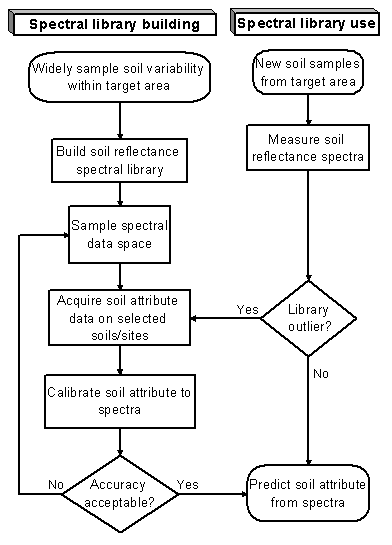| You are currently reading our legacy website. You can view our current projects here: |
OUR APPROACH
 We have proposed a scheme for the use of spectral
libraries as a tool for building risk-based approaches to soil evaluation
(Shepherd and Walsh, 2002). The first step is to widely sample the
soils from a target area and scan the samples through the spectrometer.
The ability to rapidly and non-destructively characterize soils
using reflectance spectroscopy permits thorough sampling of the
variation within a target population of soils. The spectral data
space is then systematically sampled to provide a small subset of
soils for further characterization. Soil properties or attributes
of soil functional capacity are then measured only on this selection
of soils. These attributes can include laboratory measurements (e.g.
aggregate stability) or field measurements (e.g. infiltration rate,
crop response to phosphorus application). We have proposed a scheme for the use of spectral
libraries as a tool for building risk-based approaches to soil evaluation
(Shepherd and Walsh, 2002). The first step is to widely sample the
soils from a target area and scan the samples through the spectrometer.
The ability to rapidly and non-destructively characterize soils
using reflectance spectroscopy permits thorough sampling of the
variation within a target population of soils. The spectral data
space is then systematically sampled to provide a small subset of
soils for further characterization. Soil properties or attributes
of soil functional capacity are then measured only on this selection
of soils. These attributes can include laboratory measurements (e.g.
aggregate stability) or field measurements (e.g. infiltration rate,
crop response to phosphorus application).
THE PROJECT
Calibrations are made between the soil attributes
and the reflectance spectra. If, on the basis of cross-validation
or holdout validation methods, calibrations are found to be insufficiently
accurate for user requirements, the calibration sample size can
be increased. The
resultant calibrations between soil functional attributes and soil
reflectance are then used to predict the soil functional attributes
for the entire soil library and for new samples that belong to the
same population as the library soils. Poorly described soils, whose
spectra are not representative of the library spectra, are further
characterized and added to the calibration library. In this way
the value of the library is iteratively increased.
Conventional assessments of soil capacity to perform
specific production, engineering or environmental functions rely on local
calibration of observations on soil functional attributes to measured
soil properties. However, soil analyses are expensive and dense sampling
is required to adequately characterize spatial variability of an area,
making broad-scale quantitative evaluation difficult. Infrared reflectance
spectroscopy, especially near infrared spectroscopy (NIR), is now routinely
used for rapid non-destructive characterization of a wide range of materials
in industry. Although soil scientists have investigated reflectance spectroscopy
for several decades, the technology has not been widely taken up and routinely
applied in soil studies.
|

